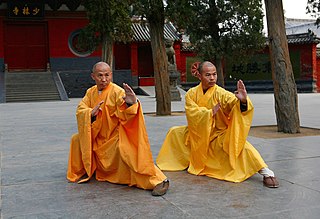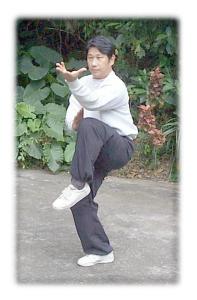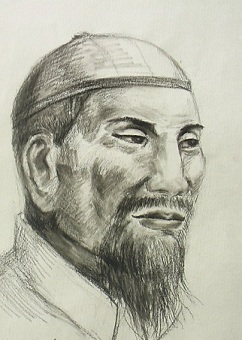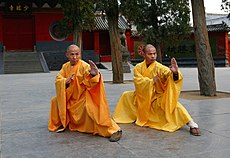
Baguazhang is one of the three main Chinese martial arts of the Wudang school, the other two being tai chi and xingyiquan. It is more broadly grouped as an internal practice. Baguazhang literally means "eight trigram palm", referring to the bagua "trigrams" of the I Ching, one of the canons of Taoism.

Guo Yunshen was a famous xingyiquan master. He represented the xingyiquan martial philosophy of preferring to become highly proficient with only a few techniques rather than to be less proficient with many techniques. His skill with one technique Beng Quan was legendary: it was said from him that "with his 'half-step bengquan', he could fight anyone under heaven without finding an equal.", and earned the nickname "the steadfast".

Dong Haichuan is regarded as a skillful martial artist and is widely credited to be the founder of Baguazhang. Most, if not all, existing schools of Baguazhang place Dong Haichuan at the beginning of their lineage. Some traditional teachers in China do not regard Dong as the founder, though, but merely as the first identified transmitter of Baguazhang knowledge to the wider public. In their opinion, prior to Dong, Baguazhang teaching was conducted behind closed doors from one Taoist to another within the Taoist sect. There are no historical evidence of practicing Baguazhang among the Taoists prior to the modern era, however.
Yin Fu was a Baguazhang disciple of Dong Haichuan responsible for the creation of the Yin Style Baguazhang.

Cheng Tinghua (1848–1900) was a renowned master of Chinese Neijia (internal) martial art Bagua Zhang.

Gao Yisheng (1866–1951) was the creator of the Gao style of the Chinese Internal Martial Art of Baguazhang. His life bridged the second generation and third generation of Bagua practitioners into the 20th century. He was one of the few third generation Bagua practitioners to live beyond the 1940s. His innovation and impact on Bagua as a fighting art cannot be underestimated.

Yin Style Baguazhang is a style of Baguazhang.

Fu Zhensong, also known by his courtesy name Fu Qiankun, was a grandmaster of Wudangquan martial arts. He was best known as one of the famed "Five Northern Tigers," and a third-generation master of Baguazhang who founded Fu Style Baguazhang. He was also a soldier and a supporter of Sun Yat-sen.

Ho Ho Choy Baguazhang is a style of Baguazhang, a Chinese martial art. Specifically, it is a substyle of Gao Style Baguazhang, which is in turn a substyle of Cheng Style Baguazhang.

Fu-style Wudangquan is a family style of Chinese martial arts encompassing tai chi, xingyiquan, baguazhang, liangyiquan, bajiquan, and Wudang Sword. Fu Style Baguazhang is one of the five styles of baguazhang recognized as orthodox in China. It is the highest form of the Fu-style martial arts.

Gao Style Baguazhang is the style of Baguazhang descended from Gao Yisheng, a student of Cheng Tinghua, who founded one of the two main branches of Baguazhang. Gao is alternatively said to have originally studied with Song Changrong (宋長榮) or Yin Fu, later studying with one of Cheng's students, Zhou Yuxiang (周玉祥). Gao style is one of the most widely practiced Baguazhang styles in the West; there are also many practitioners in Tianjin and Taiwan. It has many variations held within various lineages, some which are given below:

Luo Dexiu or Lo Te-Hsiu is a Taiwanese martial artist who specializes in the internal Chinese styles of Xingyiquan, Baguazhang, and Taijiquan.
Liang Zhenpu (梁振蒲) (1863–1932) was a Chinese martial artist.

Liang Style Baguazhang is the style of Baguazhang descended from Liang Zhenpu, the youngest disciple of Baguazhang's founder, Dong Haichuan. In general, most lineages of Liang style descend from either Guo Gumin or Li Ziming:
Li Ziming (李子鳴) was a martial arts expert and third generation descendant of the creator of Baguazhang, Dong Haichuan, under the lineage of Liang Zhenpu - progenitor of Liang Style Baguazhang.

Jiang Style Baguazhang is a style of Baguazhang developed by Jiang Rongqiao. A type of Neijia kung fu, it is one of the most widely practiced combined styles of Baguazhang and Xingyiquan in the world today. Jiang-style Baguazhang is distinguished by emphasizing efficiency of movement and ambidextrousness.

Wudangquan is a class of Chinese martial arts. In contemporary China, Chinese martial arts styles are generally classified into two major groups: Wudang (Wutang), named after the Wudang Mountains; and Shaolin, named after the Shaolin Monastery. Whereas Shaolin includes many martial art styles, Wudangquan includes only a few arts that use the focused mind to control the body. This typically encompasses tai chi, xingyiquan and baguazhang, but must also include bajiquan and Wudang Sword. Although the name Wudang simply distinguishes the skills, theories and applications of the internal arts from those of the Shaolin styles, it misleadingly suggests these arts originated at the Wudang Mountains. The name Wudang comes from a popular Chinese legend that incorrectly purports the genesis of tai chi and Wudang Sword by an immortal, Taoist hermit named Zhang Sanfeng who lived in the monasteries of Wudang Mountain. Wudang quan is often used synonymously with Neijia, but strictly speaking Neijia is a broader term that also encompasses, for example, Aikido and Qigong, which are not Wudang quan.

Xingyiquan is a style of internal Chinese martial arts. The name of the art translates approximately to "Form-Intention Fist", or "Shape-Will Fist". Also known as xingyi, it is characterized by aggressive, seemingly linear movements and explosive power that's most often applied from a short range.

Ma Gui was an accomplished master of the internal Chinese martial art of Baguazhang, and was the first disciple of Yin Fu, who in turn was the first disciple of Baguazhang's founder Dong Haichuan. Various lines of Baguazhang claiming lineage to Ma Gui are still actively taught in China as well as in Japan, North America, and Europe.

Liu Wanchuan was a master of the Chinese Neijia (internal) martial art Baguazhang. He studied extensively with the great Baguazhang master Ma Gui (1851-1941), and is considered to be one of only two modern masters to have successfully passed on Ma Gui's unique lineage to current generations. According to Liu Wanchuan, the Baguazhang style that Ma Gui taught him using "low basin, small steps, and particularly heavy power and strength," and for those who practice it regularly "at the very least it will add ten or twenty years to your life."








